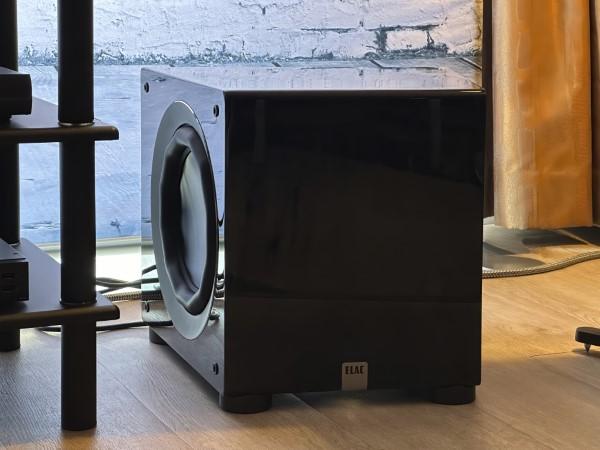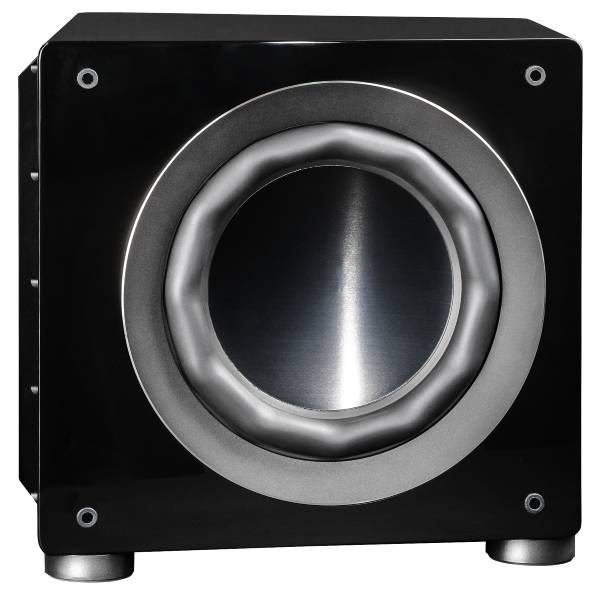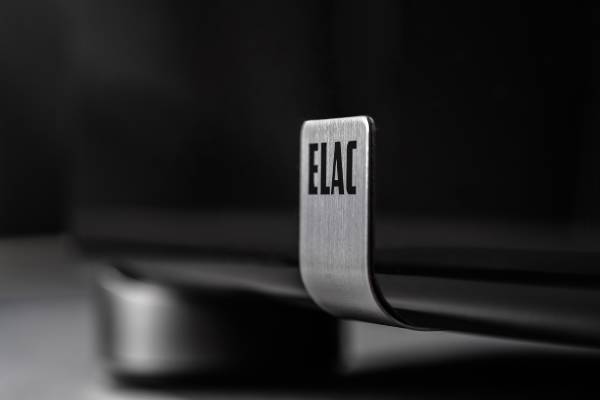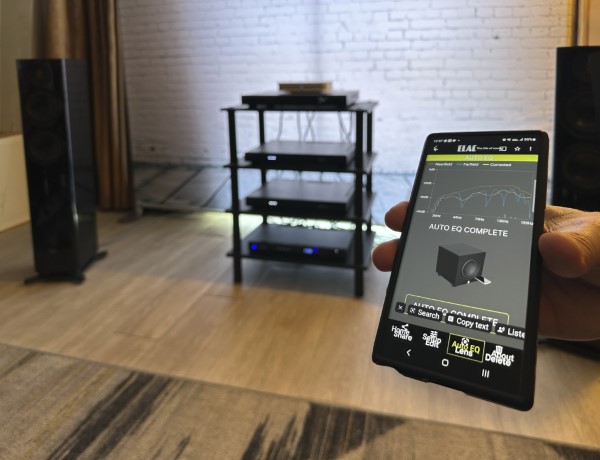ELAC DS1200 12" Dual-Opposed Subwoofer Review

AT A GLANCE
Plus
Rock solid build quality
Full featured, intuitive app
Tiny size and stylish appearance make it very decor friendly
Minus
Amp gets warm when pushed
On the expensive side
Warranty is only 1 year (*see update in the Impressions section)
THE VERDICT
A little powerhouse of a subwoofer, despite its diminutive stature the ELAC DS1200 comes ready to play. The compact size does take away
a little from the lowest octave, but its fidelity and unflappable nature easily make up for that.
When you hear the name ELAC, do you immediately think of subwoofers? Speakers yes, but probably not subwoofers. Did you know they currently sell 9 different models? What I have in front of me is their top-of-the-line; the Varro Dual Reference Series 12" subwoofer, or DS1200 for short. That’s a big name for a small sub, calling it “reference series” adds some expectations too. Can it can live up to those?
Impressions
The first thing you notice about the ELAC DS1200 is what you don’t notice, size. There really isn’t any, this thing is tiny. Measuring in at a mere 16.5"x19"x16.3 (HWD), it almost disappears in your room. Note that the 19” width is at its widest point, because the DS1200 is shaped like an isosceles trapezoid the front of the subwoofer is even slimmer at just 13.4”. Don’t let the size fool you though, the DS1200 weighs in at a stout 84 pounds. Pick it up and you feel the heft, it’s substantial for sure. The grills even get in on the act, the 7/8” thick MDF they’re made from is about as rigid and inflexible as your boss. Held in place by metal pins and rubber cups in the cabinet, the gentle taper at the front and back blends beautifully with the shape of the cabinet.
Despite the minuscule dimensions there’s a lot packed into this thing. There is not one, but two 12” drivers with their patent-pending HEX surround. That’s roughly equivalent in cone area to a single 18” driver. Naturally there’s an amplifier to motivate them, it’s so large that the plate takes up about 2/3rd’s of the back panel. There are even internal cabinet braces somehow shoehorned inside. Did I mention there’s also acoustic damping material in there? Did I neglect to bring up the fact that the cabinet walls are 1.5” thick? When you see this thing in person guaranteed you think “there’s no way ELAC stuffed all that in there”, but I can assure you they did. The proverbial knuckle rap test on the outside of the enclosure results in a dead sound, exactly what you want to hear. The cabinet is inert, even under heavy duress there is almost no vibration felt. Robust, weighty, stylish and almost invisible, ELAC did an awful lot with the DS1200.
The HEX surround is interesting, it has a dimpled appearance…

ELAC describes it thusly…
"Hex Technology surround geometry allows for very linear relationship between applied force and resulting displacement in both directions. This ensures faithful reproduction of the recorded signal with low distortion even at high playback volumes. It also keeps surround width narrower in comparison to conventional circular roll surround having the same amount of excursion. Wide surrounds take away from a cone radiating area and contribute to non-linearity since their effective radiating area changes between in and out strokes."
Small detail alert: because I review so many different subwoofers - a lot of which are visually indistinguishable - I’m wont to search for details, things that make product X stand out among the crowd. It can be something that you see, their engineering, a design element or just a little thoughtful touch a company includes that shows they were looking to differentiate their product from the masses. In the case of the DS1200 it’s the plaque on the front of the cabinet.
Centered on the bottom of the front panel is an elegant metal plate with the company logo…

Nothing too uncommon there, but in the case of the DS1200 it wraps around the bottom and continues for another inch. Big deal, since you can’t see that part who cares? Apparently ELAC. What they did was countersunk a whitish LED in the center of the bottom portion. So many times people complain about having an LED on the front of their subwoofer, mostly because it’s bright, an unpleasant color like blue or because it’s just downright distracting. By placing it on the underside of the cabinet what they did was give you an easy visual indication that the DS1200 is on, yet neither the color nor the direction of the light is the least bit annoying. Quite the contrary, in a dark room it acts as a little night light to let you know exactly where the subwoofer is so you don’t stub your toe on it. It’s low key, effective and unique. I like that. Mindful of the details, no matter how small they may seem.
ELAC sells through a network of authorized dealers, both brick-and-mortar as well as on-line. Among the latter are Amazon, Crutchfield and Electronics Expo, all big names in the field. Curiously, when I checked Electronics Expo they only show their speakers, none of the subwoofers are listed. Amazon and Crutchfield showed their full product line. You can also buy directly from ELAC of course, and if you choose that route they offer financing through Klarna. There are several different plans to choose from, including ones that are interest free, so you have options available. Another benefit of buying directly from ELAC is they provide a 30 day in-home trial with a money back guarantee.
The only color available for the DS1200 is gloss black. Typically I’m not a fan of that finish, because it tends to reflect light, but due to its size there is so little painted surface to contend with I didn’t mind one bit. To be honest, I kind of like the way it looks all dressed up in its Sunday finest.
*When this story was written ELAC offered a 1 year warranty for the DS1200. We've since been informed they have extended it to a full 5 years, covering both parts and labor. The new warranty is retroactive, every Varro subwoofer sold will automatically be upgraded. While ELAC might have already been discussing that internally, publishing this article may have helped make it a reality.
Setup
There are several ways you can set up the ELAC DS1200, the quickest and easiest of them is to use their Sub Control apps AutoEQ system. You hold your phone close to the subwoofer with the mic aimed at either driver, play a test tone, then go to the main listening position (MLP) and run the same tone a second time. It will create and then load a custom tune into the subwoofer based upon your rooms unique acoustic characteristics. I tried it when I first got the DS1200 and the results were good, but I’m more of a hands-on person when it comes to adjustments so I went with option 2; manually hand tuning using measurement equipment.

Thankfully the Sub Control app has just about every conceivable setting, including perhaps the most beneficial of them all; 8 PEQ’s (Parametric EQ’s). These allow you to specify a frequency, a level (plus or minus) and a Q value (how “wide” the adjustment is, in effect how much it influences the frequencies both before and after the one you’ve chosen). Everything was returned to factory default, I wanted to eliminate the AutoEQ settings so I had a clean slate. Using Omnimic I was able to see the peaks and valleys at the MLP that needed attention. Using 6 of the 8 PEQ’s I was able to get this at my seating position…

Given some of the room modes I have to deal with that’s an impressive response curve. I then turned off the subwoofer and ran my AVR’s room-EQ system to adjust the speakers. Why do it that way? Simple, I didn’t want my hard work being undone by any external electronic algorithms. Once the speakers were also tuned I turned the sub back on and spent a little time with some movie test material, fine tuning the phase and output level to taste. I didn’t need to touch it again during the 6 weeks the DS1200 was in rotation.
There’s also a 3rd tuning option, you can choose from one of ELAC’s preconfigured settings; Movie, Music, Night and Flat. Each has been configured to provide a different response for a particular situation.
The app naturally comes in versions for Android and iOS devices. Thankfully it only needs Bluetooth to connect, not Location services as well. Being security conscience I only enable that when using GPS. I could never understand why other manufactures force Location to be enabled just to tune a subwoofer that’s sitting right in front of me, seems totally unnecessary. ELAC doesn’t include any information about how to use the app, which is an omission as far as I’m concerned. It’s intuitive though so if you’ve ever made adjustments to a sub in the past it should all be pretty straightforward.
I did stumble upon one anomaly while using the app. A day after tuning the sub I noticed that 2 of my PEQ’s had their frequency changed by 1Hz. I reset them, closed the app, reopened it and they stayed put. A few days later I went back in and the same two PEQ’s had changed by 1Hz again. I reset them once more, closed the app, reopened it and they were as I left them. That issue didn’t happen a third time.
When you do get around to the back of the subwoofer you’ll see only a volume knob on the amp, meaning everything you need to tweak can only be accessed using the app. There’s no dearth of inputs however, ELAC includes balanced (XLR), unbalanced (RCA) and high level connectors, along with a 12v trigger, Ethernet port and USB-A for firmware upgrades. There’s also a button for wireless pairing. All Dual Reference subwoofers come with a built-in wireless receiver. By attaching ELAC’s optional AirX2 transmitter to your AVR you can connect up to 3 of subwoofers, meaning no ugly wires or placement restrictions.
Listening/In Use
My review methodology probably differs from most others in that I focus a lot of attention on how something fares in the day-to-day world, rather than just at the extremes. To me that more closely simulates real life usage because few of us are likely in the position to use our gear to its maximum with any regularity, at least if you want some semblance of hearing in your golden years that is. However, come testing time things change dramatically. There’s an axiom that goes “drive it like you stole it”, which is often used in reference to rental cars. I take a similar stance at this point in an evaluation, now I’m going to push hard. I’m looking for any weakness, a chink in the armor, in order to do that you have to pretend it’s a rental car.
Movies
As I’ve been doing recently, I began testing with the brutal opening from the movie Edge of Tomorrow. I start off at a modest volume and see what happens, it all goes according to plan I increase it and try again. This cycle continues until the subwoofer stops getting louder, or I hear ugly mechanical noises. Turns out ELAC’s protection mechanisms do their job, as I increased the volume the DS1200 got to a point where it simply didn’t get any louder. As the frequency sweep went through the 5 different levels of that opening effect everything was under control, no matter how high I pushed it there wasn’t an untoward sound to be heard. The more I cranked it the less output was observed from the 5th plateau, the deepest of them. Visibly you could even see the driver had its movement restricted once it reached a certain threshold. Personally I would prefer that to having a subwoofer try and do something it simply can’t.
For Underworld: Awakening I general start with scene 9 where the half-breed Lycan/vampire child Eve sits cutting her own arm, fascinated by how she instantly heals. Her vampire mother Selene walks in at this point, ready to gather her up and escape before the Lycans come and get her. It’s too late however as they know Eve is there, and they intend on taking her with force. The Lycans blow apart the door to the lair and come rushing in. That explosion was potent, setting the stage for the ensuing mayhem. The vampires attempt to repel the onslaught with hand-held firearms, each ‘pop’ from their automatic weapons was reproduced brilliantly by the DS1200. That’s merely an appetizer though, with this movie there’s more work to be done.
A huge toll is taken on the vampire forces, but ultimately they prevail and slay the Lycans. Save for one, a gigantic mutant version that is 5 times the size and strength of the others. Selene walks into the rotunda to face off against it, but before she even catches a glimpse of its enormity you hear those thundering footsteps. While the DS1200 did a very good job of representing the size of this monster, it wasn’t quite up to the task of hitting the lowest notes I’ve heard and felt in the past. The DS1200 distinguished itself with clarity and definition; this part of the soundtrack can get obnoxious with lesser subwoofers but there was no such issue here, it was able to render every note and element with precision.
Black Hawk Down, guess which scene I used from this movie? You’re right, it contains the word “Irene”. Honesty, I didn’t really think I was going to stump anyone.
Once the famous word has been spoken there’s a deep pulsating sensation, the very element this scene is noted for. There was certainly a sensation from the DS1200, but the deepest subterranean bass was a bit understated. The effect was there, and it was definitely evident, just not with a tremendous amount of intensity. Once the American forces have secured the prisoners their extraction begins, but while rounding them up a gun battle erupts between our soldiers and the rebel forces. All manner of hand held weapons are used, each of which was distinct. RPG’s exploded with authority, the ‘whumping’ sound from helicopter blades had a palpable sense to it. As was the case with Underworld: Awakening, dynamics were exceptional, the strength of each weapon and effect was clearly identifiable. That’s perhaps what I enjoyed the most, the amount of detail I heard.
In the movie Cloverfield, a creature from another planet invades Manhattan. The attendees of a going-away party head to the roof of their apartment building to get a better view of what's happening, when they get there a huge explosion occurs. The DS1200 obliged with a convincing blast, a harbinger of what was to come. In fear they all scramble down the stairs to the street where they’re confronted by a building collapse, courtesy of the alien itself. This part of the soundtrack builds as the debris and shock wave make its way toward the people on the street, something the DS1200 ate up. As the magnitude of the effect climbs, so too did what I heard and felt. All of it was in balance, including the guttural sounds from the alien.
A little further on they come face-to-face with one of the towering beasts out on the street. They’re caught between it and the military, who subsequently open fire on the invader. They unload with bazookas and tank mounted canons, each hitting with a percussive kick. The thing howls in anguish, his roar reverberated throughout my room. Of all the scenes I used from Cloverfield I enjoyed this one the most. It has multiple layers, if they’re rendered correctly you feel as though you were there. The DS1200 did that.
Always after a spirited movie test session I reach around the back of a subwoofer and feel the heat sink on the amplifier to see how much warmth it’s generating. On the DS1200 it was noticeable, the large heat fin was plenty warm to the touch. I didn’t hear any detrimental affects or notice a performance degradation, nor did it ever trip a thermal protection mechanism, so it was still operating within the designed parameters. When planning the location of the DS1200 in your room it’s probably wise to ensure there are no obstructions to the airflow above or to the back of the cabinet.
Music
I generally prefer to mix things up when choosing material for music, having a distinct variety for what I feature, but for whatever reason the day I decided to do this portion of the review I was a little worked up so I went mostly with vigorous music. That’s not necessarily a bad thing, because a lot of it can be an acid test for a subwoofer, but it’s just out of character.
Like a lot of aggressive songs, Stone Sour’s “Absolute Zero” has a driving rhythm. It doesn’t have the force of something from the ‘speed’ metal category, but it’s not lacking when it comes to testing a subwoofer. Johny Chow’s bass was rich and nuanced, but what was particularly impressive is how much power Roy Mayorga’s drum had. Every time he planted his foot on that kick pedal I heard a commanding thud, pretty much what I needed that night. If you want to give your sub some work, or just happen to be in a mood, give this one a listen to.
Whereas “Absolute Zero” is rather lively, “Bullet with Butterfly Wings” from Smashing Pumpkins is more of a rolling rhythm. It’s still pretty robust, just a little less spirited. This song is recorded on the heavy side, with Jimmy Chamberlin’s drums and D'arcy Wretzky’s bass sounding fairly thick. That’s not the fault of the DS1200 mind you, it’s how the track was laid down. That’s exactly why I chose it, I am testing a subwoofer after all. ELAC rewarded me with a rousing interpretation of this radio staple from the Pumpkins, replete with a substantial amount of bottom end. It came across as forceful, raucous and untamed.
Finishing off with perhaps the angriest song of the bunch, I went with Disturbed’s “Inside the Fire”. This tune was written by singer David Draiman, a release of his anguish from a time in his teenage years when his then girlfriend ended her life. Based upon the fury in this song he clearly has not gotten over it. To honor that I pushed the DS1200 harder on this one than any of the others. John Moyer (bass) and Mike Wengren (drums) get themselves a workout here, and so did my little ELAC friend. Despite the fast pace and heavy emphasis recorded into the rhythm section, the DS1200 wasn’t the least bit fazed. It soldiered on with nary a concern, even during the most intense portions it never skipped a beat.
Conclusion
The laws of physics are immutable, there is perhaps no better example of that then as they relate to subwoofers. When it comes to deep bass played at volume you need several things, chief among them is a large enclosure. The ELAC DS1200 did soften the lowest octave when I pushed the pace, but frankly that’s not the least bit surprising given the aforementioned pesky bit of physics. You can mitigate that to an extent with precision engineering, overbuilt drivers, powerful amplifiers and DSP tuning, all things ELAC includes with the DS1200. But no matter what, at some point you will hit a wall. When the DS1200 finally reigned things in it did so in a graceful and fluid manner, never once tripping over itself regardless of how hard I tried to get it to do that very thing.
I pushed this subwoofer and it did not care in the least, remaining unperturbed throughout. Add to its composure a stylish and unique appearance, along with a well thought-out app that allows for minute configuration and customization, and you get quite a lot with the ELAC DS1200.
Specs
- Enclosure: Sealed, dual opposed drivers
- Driver: 12” x2, aluminum/paper cone, HEX Surround
- Frequency Response: 17Hz - 150Hz (Anechoic)
- Amplifier Power: 1200 watts RMS, 2400 watts peak
- Amplifier Topology: BASH
- Inputs: RCA Line Level, Balanced XLR, Speaker Level
- Low Pass Crossover: 40Hz - 150Hz
- Cabinet Finish: Gloss Black
- Dimensions: 16.5"x19"x16.3 (HWD)
- Weight: 84 pounds
- App Compatibility: Android and iOS






























































